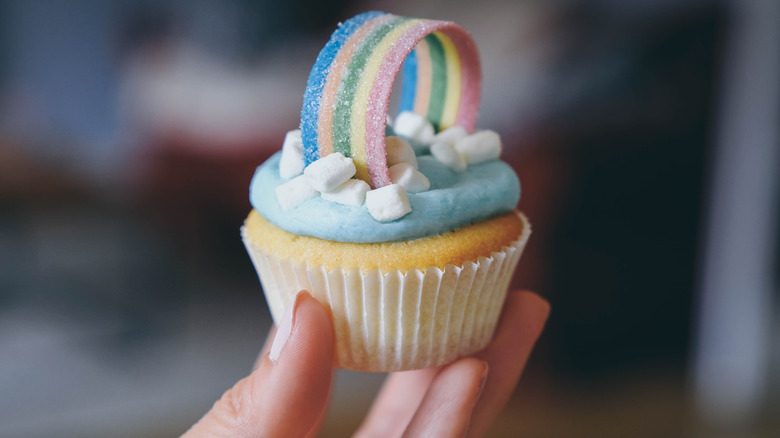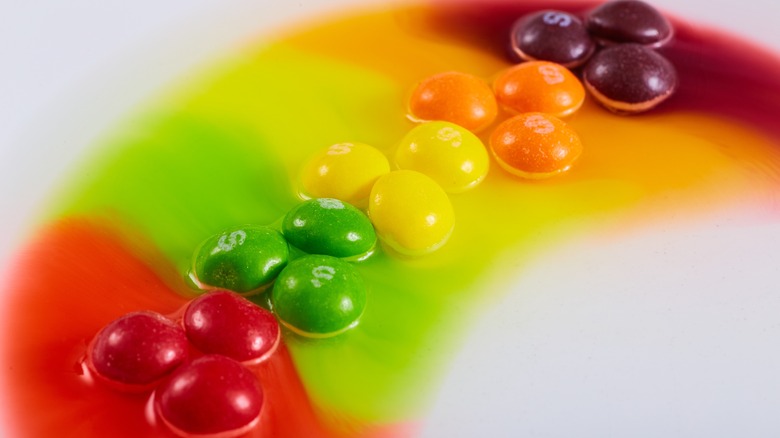Rainbow Poops Are Possible If You Eat These Foods
A colorful meal is a pleasing sight at the dinner table. From rich red peppers to bright yellow squash, emerald-green veggies, and everything in between, some experts, such as those at the National Council on Aging, actually encourage adults to craft a plate that resembles a rainbow. While these rainbow colors are more than welcome to enter the body, we don't really want these same colors coming out the other end, so to speak.
Healthy poops are usually brown in color. In some cases, however, certain food items may alter the color of your stool. After eating a spinach or kale salad, for instance, you might notice your poop taking on a more green hue (via Mayo Clinic). Cranberries and beets, on the other hand, might cause stools to appear red in color. Food-related color changes such as these aren't considered unusual and are generally temporary. However, there are other foods that can produce bowel movements in which no color is off the table. It looks as if unicorns aren't the only creatures that can poop the rainbow after all.
Foods with artificial dyes can produce poops of any color
Ingesting foods that contain artificial food dyes can lead to rainbow poops, according to Cleveland Clinic experts. In other words, you may look down after using the bathroom and see any possible color. These kinds of foods include powdered drink mixes, popsicles, icing, or multi-colored candies, just to name a few (via Mayo Clinic). Green dye #3 and Red dye #40 are two examples of such artificial ingredients that can be found in foods like Jell-O or Froot Loops cereal (via Muscle and Fitness).
If you grew up in the early 70s, you might remember Franken Berry, a popular children's cereal released just in time for spooky season (via Smithsonian Magazine). Many consumers, particularly kids, soon developed a side effect nicknamed "Franken Berry Stool," in which fans of the cereal produced bright pink poops due to the Red dye No. 2 and No. 3 ingredients. While Red No. 2 has since been banned in the U.S., Red No. 3 is still permitted for use in foods except in the state of California (via NBC News). Other rainbow poop-producing cereals that emerged on the market over the years included General Mills' Boo Berry and Post Cereal's Smurfberry Crunch. Although many of these products have since been discontinued, NPR reported in 2022 that both Franken Berry and Boo Berry returned to store shelves during the month of October for a limited-edition walk down memory lane.
When to seek medical care for rainbow poops
While you won't find it in a rainbow, another color you might see in the toilet after eating a large amount of multi-colored candies is black from all the dyes blending together (via Cleveland Clinic). If you're a fan of black licorice, this can turn stool black, reports the Mayo Clinic.
Rainbow poops usually go away once the food has worked its way out of your system. However, these are instances in which black poop or bright red poop, in particular, may indicate a health issue. Black stool can potentially signal bleeding in the stomach, while red poop can be indicative of bleeding in the rectum or large intestine. Reach out for medical help if you experience any concerning color changes in your poop, especially if accompanied by additional symptoms like pain, diarrhea, or fever.
At the end of the day, while Skittles may encourage us to "Taste the Rainbow," this may be better achieved through a selection of colorful fruits, veggies, whole grains, and lean proteins rather than with foods saturated with artificial dyes.



